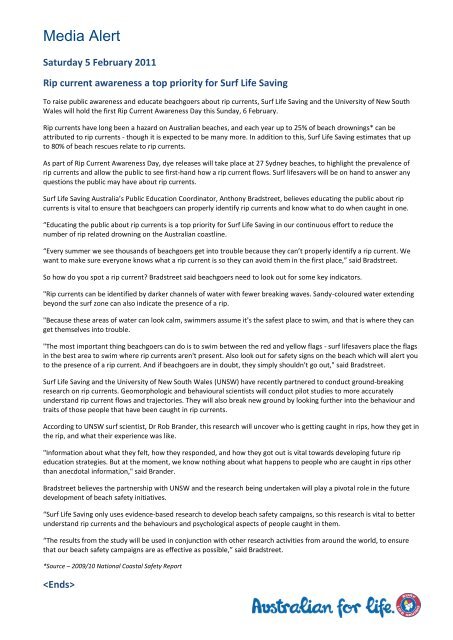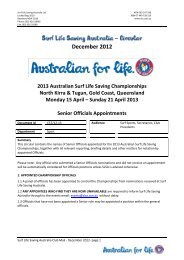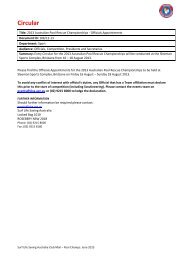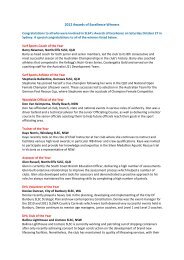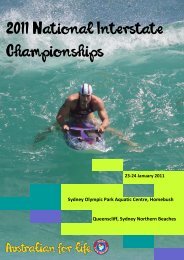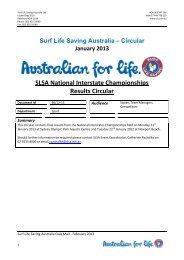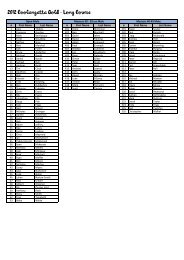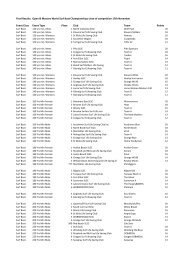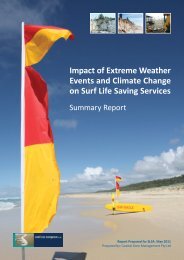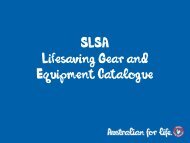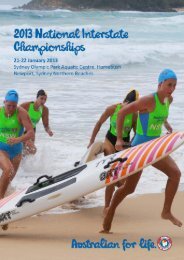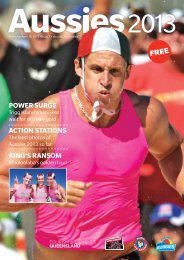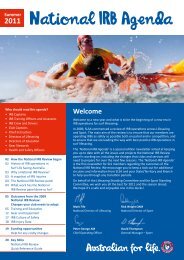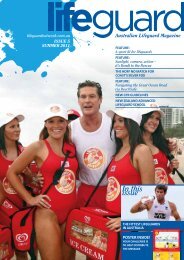Rip current awareness a top priority for Surf Life Saving
Rip current awareness a top priority for Surf Life Saving
Rip current awareness a top priority for Surf Life Saving
Create successful ePaper yourself
Turn your PDF publications into a flip-book with our unique Google optimized e-Paper software.
Media AlertSaturday 5 February 2011<strong>Rip</strong> <strong>current</strong> <strong>awareness</strong> a <strong>top</strong> <strong>priority</strong> <strong>for</strong> <strong>Surf</strong> <strong>Life</strong> <strong>Saving</strong>To raise public <strong>awareness</strong> and educate beachgoers about rip <strong>current</strong>s, <strong>Surf</strong> <strong>Life</strong> <strong>Saving</strong> and the University of New SouthWales will hold the first <strong>Rip</strong> Current Awareness Day this Sunday, 6 February.<strong>Rip</strong> <strong>current</strong>s have long been a hazard on Australian beaches, and each year up to 25% of beach drownings* can beattributed to rip <strong>current</strong>s - though it is expected to be many more. In addition to this, <strong>Surf</strong> <strong>Life</strong> <strong>Saving</strong> estimates that upto 80% of beach rescues relate to rip <strong>current</strong>s.As part of <strong>Rip</strong> Current Awareness Day, dye releases will take place at 27 Sydney beaches, to highlight the prevalence ofrip <strong>current</strong>s and allow the public to see first-hand how a rip <strong>current</strong> flows. <strong>Surf</strong> lifesavers will be on hand to answer anyquestions the public may have about rip <strong>current</strong>s.<strong>Surf</strong> <strong>Life</strong> <strong>Saving</strong> Australia’s Public Education Coordinator, Anthony Bradstreet, believes educating the public about rip<strong>current</strong>s is vital to ensure that beachgoers can properly identify rip <strong>current</strong>s and know what to do when caught in one.“Educating the public about rip <strong>current</strong>s is a <strong>top</strong> <strong>priority</strong> <strong>for</strong> <strong>Surf</strong> <strong>Life</strong> <strong>Saving</strong> in our continuous ef<strong>for</strong>t to reduce thenumber of rip related drowning on the Australian coastline.“Every summer we see thousands of beachgoers get into trouble because they can’t properly identify a rip <strong>current</strong>. Wewant to make sure everyone knows what a rip <strong>current</strong> is so they can avoid them in the first place,” said Bradstreet.So how do you spot a rip <strong>current</strong>? Bradstreet said beachgoers need to look out <strong>for</strong> some key indicators."<strong>Rip</strong> <strong>current</strong>s can be identified by darker channels of water with fewer breaking waves. Sandy-coloured water extendingbeyond the surf zone can also indicate the presence of a rip."Because these areas of water can look calm, swimmers assume it's the safest place to swim, and that is where they canget themselves into trouble."The most important thing beachgoers can do is to swim between the red and yellow flags - surf lifesavers place the flagsin the best area to swim where rip <strong>current</strong>s aren't present. Also look out <strong>for</strong> safety signs on the beach which will alert youto the presence of a rip <strong>current</strong>. And if beachgoers are in doubt, they simply shouldn't go out," said Bradstreet.<strong>Surf</strong> <strong>Life</strong> <strong>Saving</strong> and the University of New South Wales (UNSW) have recently partnered to conduct ground-breakingresearch on rip <strong>current</strong>s. Geomorphologic and behavioural scientists will conduct pilot studies to more accuratelyunderstand rip <strong>current</strong> flows and trajectories. They will also break new ground by looking further into the behaviour andtraits of those people that have been caught in rip <strong>current</strong>s.According to UNSW surf scientist, Dr Rob Brander, this research will uncover who is getting caught in rips, how they get inthe rip, and what their experience was like."In<strong>for</strong>mation about what they felt, how they responded, and how they got out is vital towards developing future ripeducation strategies. But at the moment, we know nothing about what happens to people who are caught in rips otherthan anecdotal in<strong>for</strong>mation," said Brander.Bradstreet believes the partnership with UNSW and the research being undertaken will play a pivotal role in the futuredevelopment of beach safety initiatives.“<strong>Surf</strong> <strong>Life</strong> <strong>Saving</strong> only uses evidence-based research to develop beach safety campaigns, so this research is vital to betterunderstand rip <strong>current</strong>s and the behaviours and psychological aspects of people caught in them.“The results from the study will be used in conjunction with other research activities from around the world, to ensurethat our beach safety campaigns are as effective as possible,” said Bradstreet.*Source – 2009/10 National Coastal Safety Report
Media AlertFor further in<strong>for</strong>mation or to arrange a media interviewMatthew MyersMedia and Communications Executive<strong>Surf</strong> <strong>Life</strong> <strong>Saving</strong> Australia0402 850 988www.sls.com.auMedia call – Sunday 6 FebruaryDr Rob Brander and Anthony Bradstreet will be holding a media call at Bondi Beach on Sunday, 6 February to discuss rip<strong>current</strong> <strong>awareness</strong> day and the partnership between SLS and UNSW. At the same time, rip <strong>current</strong> dye releases (seebelow image) will be held simultaneously at Bondi Beach and at 26 other Sydney beaches.Time/date of media call:Sunday 6 February 2011, 3.30PMSpokespeople:Anthony Bradstreet, Public Education Coordinator (<strong>Surf</strong> <strong>Life</strong> <strong>Saving</strong> Australia)Dr Rob Brander, <strong>Surf</strong> Scientist (UNSW).Location of media call:Bondi Beach, Southern End near the Black Sunday memorial plaque, Notts AvenueDye release locations:Eastern Suburbs: Bondi, Tamarama, Bronte and MaroubraNorthern Beaches: Manly, Queenscliff, Freshwater, South Curl Curl, North Curl Curl, Dee Why, Long Reef, Narrabeen,North Narrabeen, Warriewood, Mona Vale, Bungan, Newport, Bilgola, Avalon, Whale Beach and Palm BeachSutherland Shire: Elouera, Wanda, North Cronulla, Cronulla,Media interviews:Anthony Bradstreet and Dr Rob Brander will be available throughout Sunday and Monday <strong>for</strong> media interviews.Please note:NSW DECCW and local council authorities have approved the event and dye releases. The general public cannot releasechemicals into the environment, SLSA has received special consideration to release small quantities <strong>for</strong> raising surf safety<strong>awareness</strong>, educational and research purposes.Example of a rip <strong>current</strong> dye release at Tamarama Beach.


